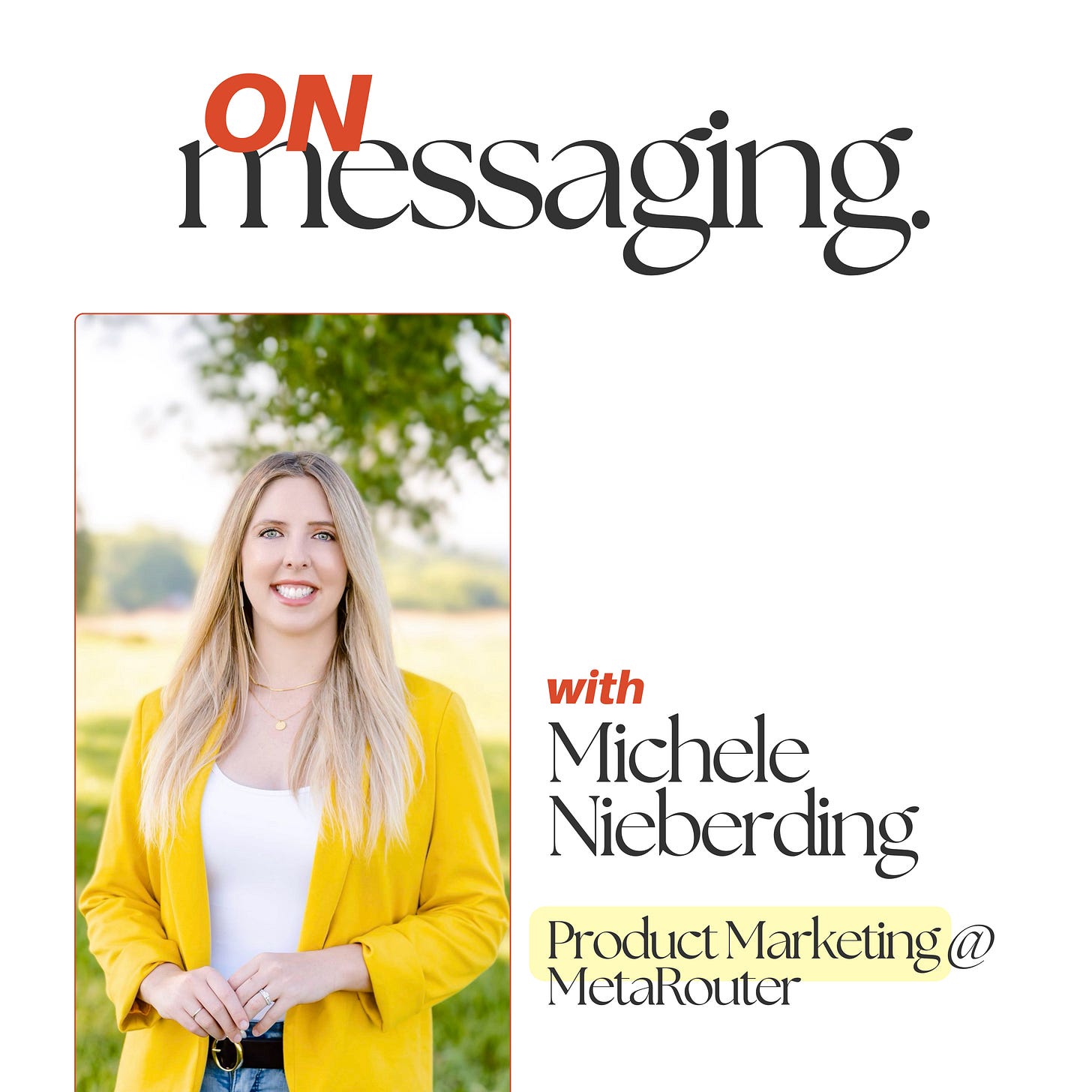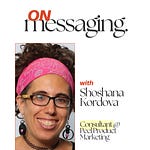Listen now on YouTube, Spotify, and Apple Podcasts!
On the show today, we have Michele Nieberding, the Director of Product Marketing at MetaRouter.
Before joining MetaRouter, Michele worked in product marketing Iterable, Qualtrics, and Cvent.
Michele’s been named a two time Top 100 Product Marketing Leader by Product Marketing Alliance.
Here are the key themes and ideas from my time with Michele:
Defining the Difference Between Positioning and Messaging
Michelle emphasizes that messaging is what gets people excited to talk to you:
"It's that first impression that can make or break the the conversation because if your messaging is really off or really incorrect, you turn people off from the get-go and that's a problem.
And if it really resonates, those are the moments that people are like, 'Oh my gosh, I need to show my boss or my team or whatever. about this tool and that's when the conversations really get going.'"
She differentiates messaging from positioning: Positioning defines the strategy (where you fit, why you matter), while messaging surrounds that to communicate the story or narrative.
She uses the analogy of a Christmas present 🎁
"Positioning is the core Christmas present that you're wrapping and then wrapped in a box of messaging and maybe on top is the bow, which could be like your tagline or your elevator or maybe some value props"
Category Creation: A Hot Take
Michelle expresses a strong opinion against category creation, calling it a "waste of time" and "risky" 🌶️ She believes the rewards are often not worth the risk, especially for smaller companies.
She shares a story from MetaRouter: Initially built around "Customer Data Infrastructure (CDI)," a vague category, then narrowed to "server-side tag management" (too narrow), and finally settling on "data collection integration."
The problem with creating a category is that you also have to educate people about the category itself, in addition to your product. This requires significant budget and resources.
She uses the example of a company called Spekit that coined the term "just in time learning" which was not well received, and eventually pulled back to sales enablement.
Larger companies might be able to pull it off. Michelle believes Gong successfully coined "conversational intelligence", but even then, customers buy it to solve a problem, not just because of the category.
Michele’s Product Marketing Bible
Let me introduce you to Michele’s "Product Marketing Bible" – a foundational messaging guide containing everything from elevator pitches and personas to use cases, stats, and customer stories.
This document serves as a single source of truth for all teams (sales, customer success, partnerships).
She does quarterly audits of the messaging, updating the document and holding enablement sessions to explain changes.
The messaging guide is a great starting place for training AI tools to help better know the product, market, competition and value props for future prompting.
Using AI for Messaging and Research
Michelle describes a powerful AI workflow using Perplexity and Google Notebook LM.
Perplexity is used for research (market trends, competitor analysis) because it provides citations.
Google Notebook LM indexes internal (pitch decks, documents) and external (websites, PDFs) information, consolidating it with the Perplexity research.
The mix of both AI tools is great for building battle cards quickly.
She also recommends "Prompt Genie" for generating better prompts for tools like ChatGPT.
How to Craft Messaging for Technical Products
Technical messaging can fail if it doesn't clearly communicate the value and impact of the product. It's important to explain why people should care about the technical solution, avoiding reliance on buzzwords.
Storytelling is crucial, even in technical fields. Use customer stories or strong narratives to help explain the "so what" and why it matters.
Talk to subject matter experts (engineering, product) and ask questions to help build accurate messaging.
"If you're not saying the right things or using the right verbiage, especially in a technical solution, you can turn people off pretty quickly. There's like some big implications to to getting that right.”
She uses the example of a news story that went viral about Target exposing a teenager's pregnancy to her father based on her purchasing data. She used this story as a campaign about data protection and not letting Facebook WebMD your customers.
Messaging for Multiple Personas
MetaRouter's users are often product managers and data scientists, while the budget holders are marketers.
Find shared pain points and unified outcomes between the different personas.
She recommends focusing on a "common enemy" to unify messaging to everyone. (Like making sure data is compliant)
Tailor specific language and benefits to each persona.
She advocates for quality over quantity, limiting personas to 3-5 max. Too many, and you won't be able to support them effectively.
Knowing When Your Messaging Resonates
Personal validation comes from hearing positive feedback from the CEO, sales team, or customers who say they've seen the messaging "everywhere."
From a data-driven perspective, win rates are the most important metric. If deals aren't closing, there's a problem with the messaging.
"If sales isn't hitting their goals, I'm doing something wrong."
There's a difference between top-of-funnel and bottom-of-funnel messaging.
Top-of-funnel: Focus on who you are, what you do, and solving the right pain points.
Bottom-of-funnel: Focus on the technical details, how you're different, and customer testimonials.
Customer testimonials are not important until bottom-of-funnel.
Validating messaging is like tuning a radio. She says it's about finding the point where the message "sounds just right," cutting through the noise and static. These moments of clarity are validating and demonstrate the impact of product marketing.
Quick Advice on Messaging
Clarity is key. Don't try to cram everything into your messaging.
Consistency is key. Use the same words your customers use. Repeat the message.
Don't be afraid to be creative! Elevate the core messages with creative campaigns. Find recent news stories you can tie a campaign to. B2B doesn’t have to be boring!
What is Living all about for Michele
Living is all about making the most of every moment. This means finding a balance, whether in professional or personal pursuits, that brings happiness and allows one to feel energized and purposeful. If that spark of life is lost, it is time to make a change.
For Michelle, maintaining this spark involves:
Finding joy and meaning in work, even if it's challenging.
Having personal interests, such as golf, that provide enjoyment and teach valuable lessons like patience.
Embracing new experiences and being willing to learn, even as an adult.
Seeking activities that re-energize and provide a sense of accomplishment, helping to balance out difficult moment.
Here’s what’s covered in our conversation:
00:00 Introduction to Product Marketing and Messaging
01:25 The Importance of Messaging in Product Marketing
02:45 Michele’s Definition of Messaging
07:26 Category Creation vs. Messaging: A Hot Take
10:07 Understanding Customer Perspectives on Categories
13:10 Maintaining Messaging Consistency Across Teams
16:17 Leveraging AI Tools for Messaging and Research
19:18 Crafting Messaging for Technical Products
22:11 The Role of Storytelling in Technical Messaging
25:20 Engaging with Subject Matter Experts for Accurate Messaging
34:26 The Impact of Targeted Advertising
39:06 Navigating Multiple Personas in Messaging
46:50 Measuring Messaging Resonance
50:04 Understanding the Messaging Funnel
53:32 Key Messaging Takeaways
Referenced:
MetaRouter: https://metarouter.io
Iterable: https://www.iterable.com
Qualtrics: https://www.qualtrics.com
Cvent: https://www.cvent.com
Product Marketing Alliance: https://www.productmarketingalliance.com
Tealium: https://tealium.com
Spekit: https://spekit.com
Gong: https://www.gong.io
We're Not Marketers: https://werenotmarketers.com
Claude AI: https://www.anthropic.com/claude
Perplexity: https://www.perplexity.ai
ChatGPT: https://chat.openai.com
Google NotebookLM: https://www.notebooklm.google
Prompt Genie: https://www.promptgenie.com
Gartner: https://www.gartner.com
Forrester: https://www.forrester.com
Target: https://www.target.com
Facebook: https://www.facebook.com
TikTok: https://www.tiktok.com
Opus Clip: https://www.opus.pro/
Instagram: https://www.instagram.com
WebMD: https://www.webmd.com
Riverside: https://www.riverside.fm
Created by Josh Chronister
I interview the best product marketers and tech companies who create messaging that resonates with their buyers. Come learn from them, so you can hit ‘Publish’ with confidence.















Share this post